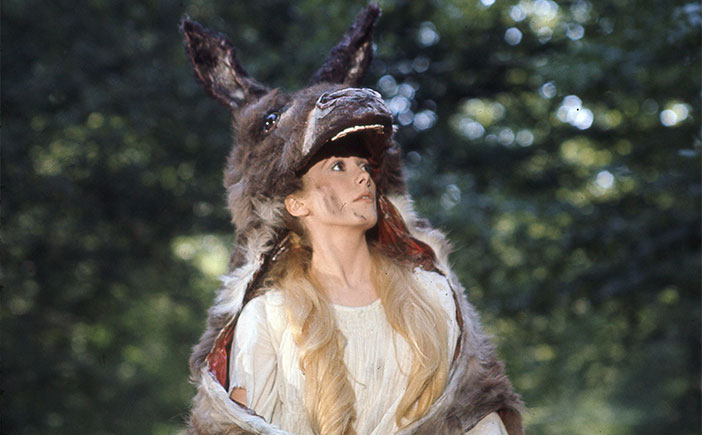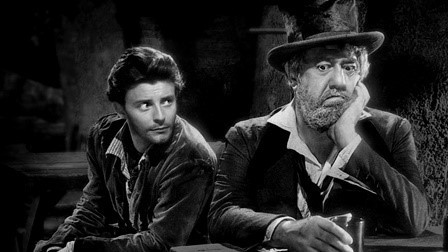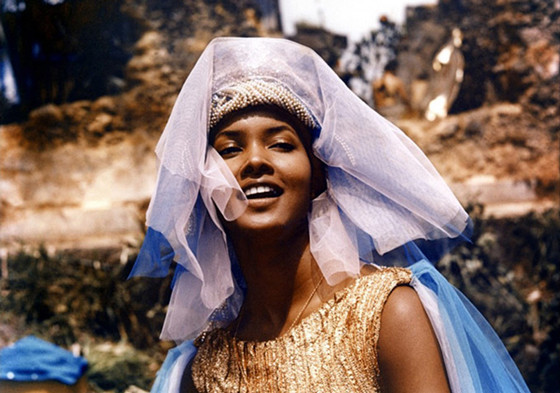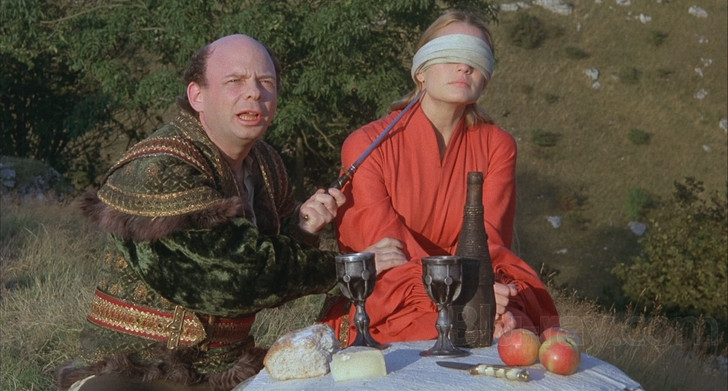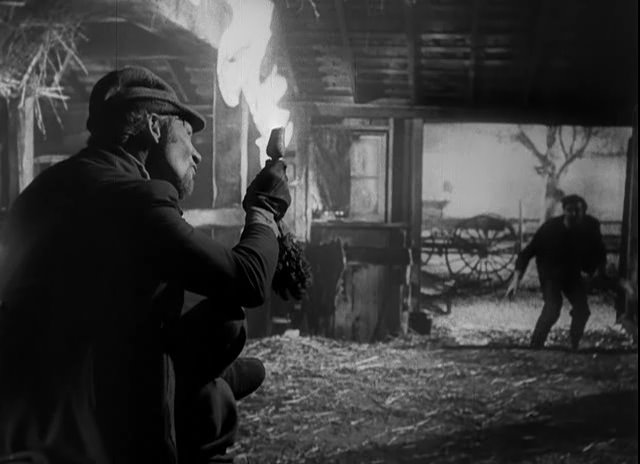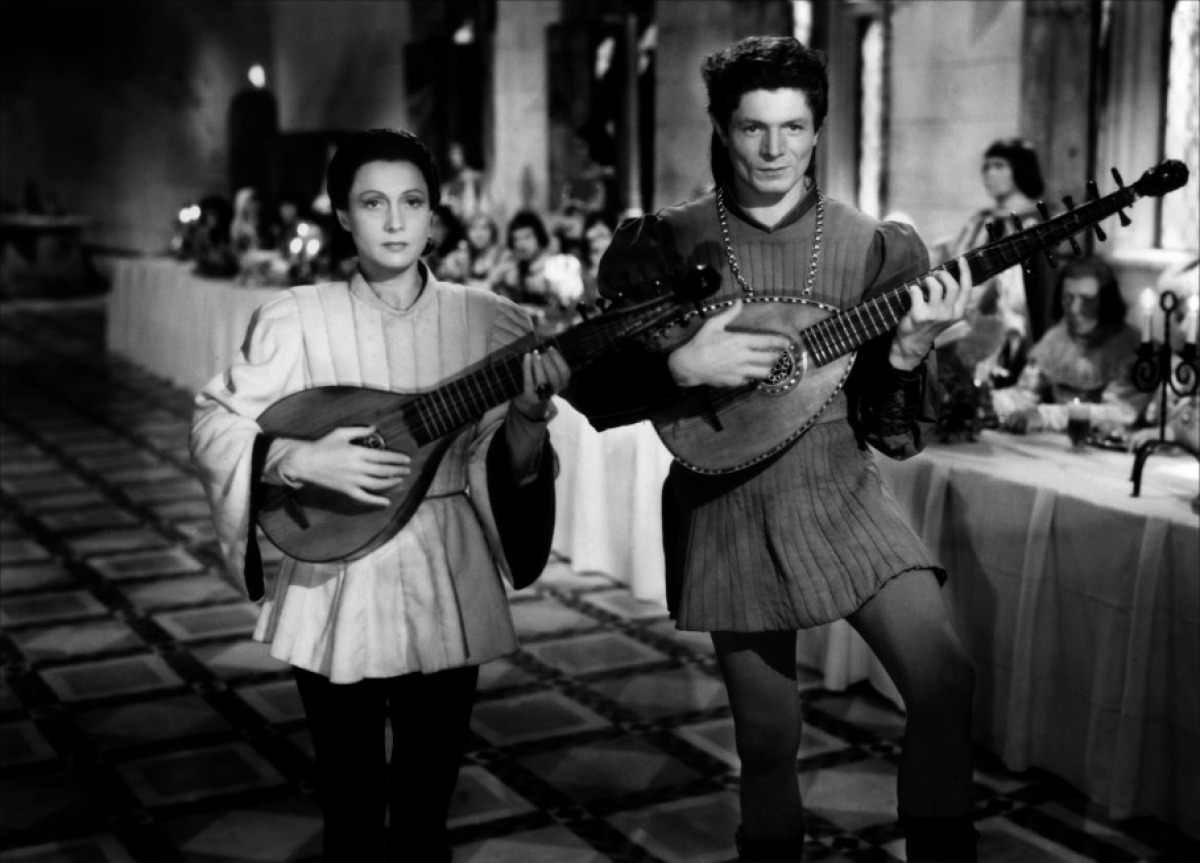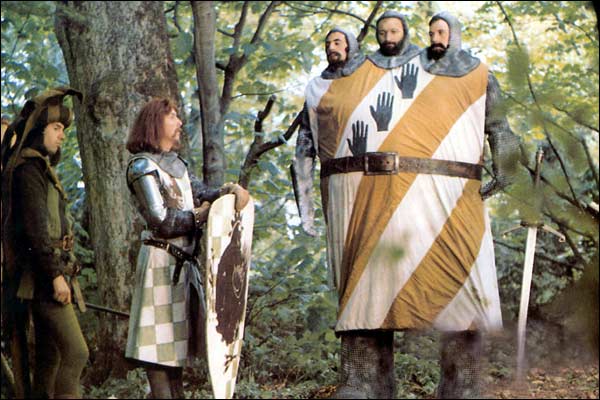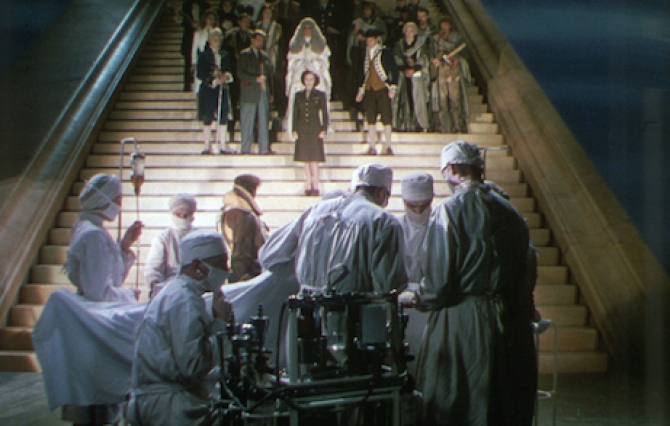17. Donkey Skin (1970)
French director Jacques Demy always made films that seemed fantastic, even when they were supposed to be realistic. It was obvious that the man was a champion dreamer who wanted the world to be so much more lovely than it is. It’s not a surprise, then, that as his films became more and more like fairy tales he eventually actually created real one!
Though taken from a story by Charles Perrault, this could only be a tale for adults. A king (Jean Marais) of a magical kingdom has been left a widower when his beautiful wife (Micheline Presle) dies. Before she passes away she makes him promise that he will only remarry someone as pretty as herself. Too bad that the only one who fits the bill is their daughter (Catherine Deneuve)!
The king and his council are willing to overlook that little fact but the princess isn’t and demands one seemingly impossible task after another before consenting to marriage. When he gives her the magical donkey skin that produces the jewels that keep the kingdom afloat, the princess decides that the time has arrived to beat it so she runs away to yet more mystical adventures.
Demy obviously learned a thing or two from Cocteau, though unlike the work of the earlier and more mystical film maker, Demy’s film is in very vibrant primary colors. Everyone is bright and sunny and loves song and dance and gets along by the end. That he could do all of that with a straight face and not be stoned to death was a miracle but it’s also obvious that he knew his innerchild just as Cocteau did and that he could also relate that inner child’s feelings on celluloid in an adult manner.
16. The Beauty of the Devil (1952)
Faust returns again in another comic version (anyone wanting to see a serious version should seek out Murnau’s silent classic of 1926). With this film. Rene Clair created another delightful fantasy, this time using the age old story of Faust. Clair chose two of France’s most beloved cinematic treasures, Michel Simon, a wonderfully shaggy, warm hearted comic actor and Gerard Phillippe, perhaps the most handsome man to ever appear on screen who could actually ACT!
In the film, a retiring chemistry professor, Faust (Simon) isbrilliant in the lab but a mess everywhere else. Hedespairs of everything he hasn’t accomplished in his life and career. Enter the devil’s servant, Mephistopheles (Phillippe) who offers renewed youth and, to sweeten the deal, he will trade bodies with the old man all for such a little thing as his soul.
Who could resist? Not the professor, though it turns out that Mephistopheles is a lot older and wiser than he looks and he has, to the surprise of only Faust, a lot of tricks up his sleeve.
Clair had lost little of his wit or visual style and the principals show why they are among the greats of French cinema. Is it original? No, but sometimes its more in how something is done than anything else. This is a funny, civilized, professional entertainment and well worth the time and effort.
15. Black Orpheus (1959)
The myth of Orpheus returns yet again in this ultra-colorful Brazilian film which is as lovely in its own way as the Cocteau version.
In this version, set during Rio’sCarnival, Orpheus (Breno Mello) is a street car conductor and singer who meets sweetly lovely young Eurydice (Marpressa Dawn) when she comes from her home in the country to attend Carnival. Though he is engaged to another he falls quickly for the young women and she for him.
Unfortunately, Orpheus’ fiancée, Mira (Lordes de Oliveira), is lethally jealous and she isn’t Eurydice’s only concern. It seems that the young woman has come from the country not to attend Carnival but in order to escape from a man she is sure will bring death to her. Sad to say, he is also in Rio, dressed in a death-like skeleton costume, complete with skull mask.
As the film progresses it becomes more and more like a fable for adults and there could be no better setting for it than the surreal Carnival . Much of the film was shot on location yet everything seems larger and more colorful than life. In this setting the increasingly mystical story seems logical and the samba soundtrack is a perfect touch. Thanks to all of this the film’s tragic ending seems like the ending of a sad fairy tale and yet is still beautiful.
14. The Princess Bride (1987)
In 1973 Oscar-winning screen writer William Goldman, who was also a best selling novelist, had a another chart topper with his novel, The Princess Bride. It wasa parody of fairy tales in which a dashing young man is on a quest to save his beloved Princess Buttercup from a variety of mystical villains and perils with ironic running commentary by the author. Goldman, who had never sold and adapted one of his own novels to film, hoped to finally do so with this book. Hedid, though it took him a decade and half to make it happen.
Goldman and director Rob Reiner solved the problem of the book’s comic voice by framing the story with a grandfather (Peter Falk) telling his reluctant grandson (Fred Savage) a story he heard in his own youth.
Cary Elwes and Robin Wright play the romantic couple, with Chris Sarandon, Wallace Shawn, wrestler Andre the Giant, Billy Crystal, Carol Kane, Christopher Guest, and Peter Cook playing various evil nobles, likable pirates, and mystical folks who help and/or hinder the lovers. Reiner, as with so many fantasy directors, finds a visual style that shows this tale to be something outside of reality, making it one of the most charming Hollywood films of its time.
13. The Devil and Daniel Webster (1941)
As war clouds began to darken America’s horizon fantastic stories and images began to appear with greater frequency on screen. Many of these dealt with the afterlife and angel and devils, with the ultimate Devil being prominent among them. One of the best of the films involving the Devil was based on a short story from the great American writer Steven Vincent Benet. It was realized by a German silent actor turned director.
From this unlikely filmmaker The Devil and Daniel Webster turned out to a fine piece of Americana, a period piece and a fantasy film. Basically, this is a folksy version of Faust as a down on his luck farmer in 19th century New England swears to sell his soul for prosperity and, being a stubborn New Englander, can’t back down when “Mr. Scratch” comes to seal the deal. After years of living the good life and neglecting his family, he runs to honest politician Daniel Webster to break the bargain legally.
Even the fantasy elements such as the trial with the supernatural jury, seem authentic to the time and place. The cast consisting of James Craig as the famer, Anne Shirley as his wife, Jane Darwell as his mother, Simone Simon as the woman “from the far side of the mountain”, and Edward Arnold as Daniel Webster are terrific.
However, all of them pale next to Oscar nominated Walter Huston as the sly, clever, duplicitous and very funny yet highly unnerving Devil. There are many great elements in this film (including Bernard Hermann’s Oscar winning score) but Huston is the greatest.
12. Heaven Can Wait (1943)
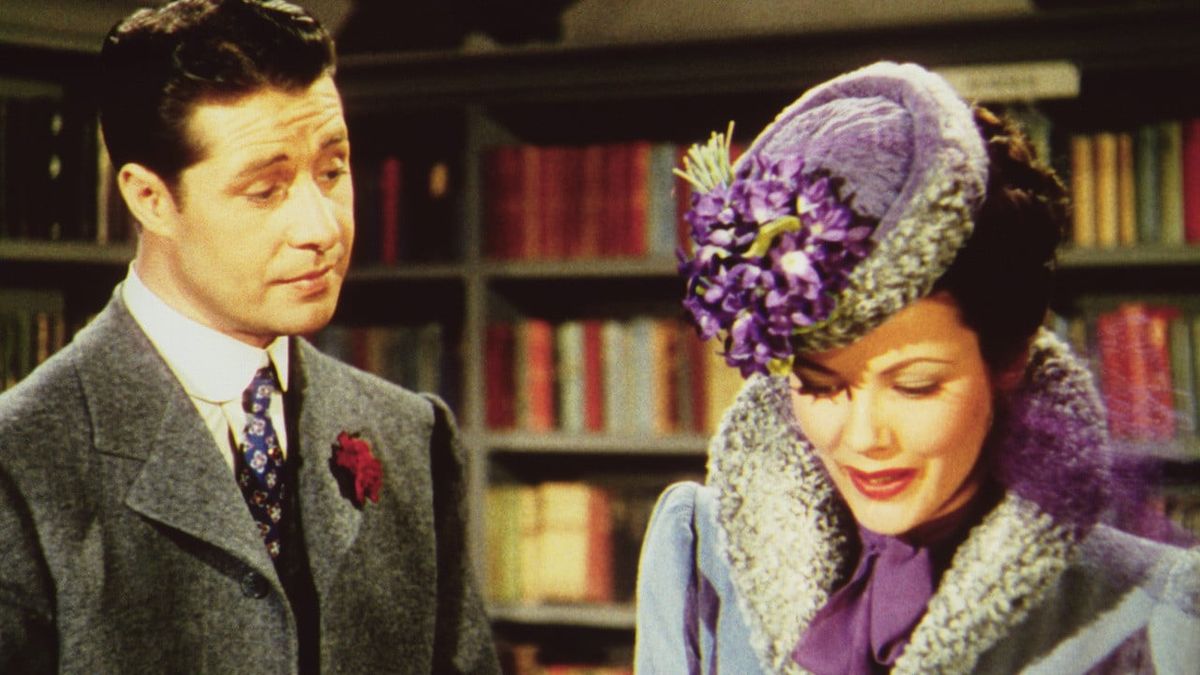
The extraordinary Ernst Lubitsch was best known for the comedies he created. They exhibited “The Lubitsch Touch”, a delicately understated sophistication married to a saucy, wry sense of humor. For his first film at 20th Century Fox he bent his style to a more domestic tale and added the trademark lush Fox color.
The story concerns an elderly well-heeled gentleman recounting the story of his life, which includes a long stretch as a gay young blade cutting through New York City society in the late 19th and early 20th centuries. So, where is the fantasy element? Well, the gentleman (Don Ameche) is recently deceased and the personage to whom he is telling his tale is His Honor, a.k.a The Devil (and Laird Gregar’s is the most urbane and congenial of the appealing devils on this list).
Why is he telling his tale to the Devil? Well, the man thinks his life had been misspent and, thinking Heaven is out for him, is submitting his case to enter Hell. Actually, this is a gentle and lovely film and by the end no one will think that the man will be going to Hell.
Still the journey is nice and Lubitsch fills the film with such able actors as Charles Coburn, Marjorie Main, Eugene Palette, Spring Byington and Gene Tierney. Though Lubitsch’s famed saucy continental wit is transformed somewhat, the humor quotient is still quite high, even in a surprisingly elegant outer office to Hades.
11. Les Visiteurs du Soir (1942)
The French did not have an easy time of it during their nation’s occupation by Germany during World War II. Many films were made which were allegories about staying strong against a hated enemy. Perhaps no film better illustrates this point better than director Marcel Carne and writer Jacques Prevert’s Les Visiteurs du Soir.
At that time the French were forbidden from making films set in the present day unless the films were propaganda pieces. Thus the writer and director took a French legend from the 15th century and gave it a sly modern spin. The Evil One (wonderfully played by Jules Berry) sends two envoys (Alain Cuny and the luminous Arletty) to a noble’s castle in order to corrupt the occupants, notably the lovers there.
However, when the disciples start to succumb to more earthly magic and spells, the Devil comes to put paid to all involved, but can’t extinguish the spirit of love and nobility. Looking at the film now it’s quite plain that the Devil and his minions were the occupiers and while they might be able to constrain those in their orbit they can’t control the indomitable human spirit. Surely that was apparent but disguised in period form the filmmakers got away with it.
Carne, not a director of fantasy, does provide a number of superb fantasy sequences, notably the scene where Arletty enchants the dancers with her mandolin. This is a haunting film in many ways.
10. Monty Python and the Holy Grail (1975)
One of the glories of early 1970s British television was the sketch comedy show “Monty Python’s Flying Circus.” As the show was completing its run the group ventured into film. Their first film, And Now For Something Completely Different, was a filming of some of their better TV material. The next, and the one that has remained the group’s most popular film offering, was their off the wall take on the legend of King Arthur and Camelot: Monty Python and the Holy Grail.
The film takes place in an England that never was and never could have been. King Arthur (Graham Chapman) and his squire, Patsy (American-born Terry Gilliam, who also directed the film) go on a series of seriously silly and wildly unreal adventures which include a killer rabbit guarding a treasure, an inept knight who won’t stop challenging the King even after all of his limbs have been severed, and a three-headed giant.
As he would continue to do in his later films Gilliam juxtapositions the most incredible flights of fancy next to a surprisingly convincing period setting. Though all of the Python films are enjoyable in their loosely structured way, this was the one that held real magic for the public and does so to this day, being turned into the hit Broadway musical, Spamalot.
9. A Matter of Life and Death (1946)
The Archers, director-writer teammates Michael Powell and Emeric Pressburger, were never ever short of original ideas. Just as the war was ending they came up with a stupendous film that was a meditation on the recent war and its human cost, yet made points without being heavy or maudlin. In fact, never was a film with so serious a subject as amazingly fun as A Matter of Life and Death (aka Staircase to Heaven).
The story takes place in the latter days of the war. As the film opens an RAF pilot (David Niven) is in a real jam. His plane is going down in flames over the English Channel and all the crew members have either parachuted out or are dead, like his co-pilot (Robert Coote). Niven gave all the parachutes to his men and is radioing to a nearby control tower manned by American WAF June (Kim Hunter). The two have never met but seem to fall in love as he bravely says he going to try and make a swim for it.
The film cuts to an office-like Heaven (in black and white, contrasting with the vibrant color of Earth) where Niven’s co-pilot is waiting for him. The co-pilot is sternly told that the pilot is expected and that if he doesn’t show soon an alarm will sound. At that moment the alarm sounds.
It seems that the Heavenly messenger sent to fetch the pilot’s soul, a beheaded French aristocrat (played by a wonderfully effete Marius Goring) lost his way in the fog. The pilot has washed up on the beach, alive, has met June and they are falling in love. Too bad Heaven still wants its new soul.
This film is a tour-de-force with scenes in the monochromatic Heaven imaginatively intertwined with those on the colorful Earth, excellent performances by all including Roger Livesey, Raymond Massey and Kathleen Byron. However, the director-writer team are the real stars. The film is a thoughtful study in life, death, eternity, immediacy, and the things that make life worth living even in a rough time. As usual with The Archers, the spiritual realm is nice but Earth can be pretty heavenly too.
